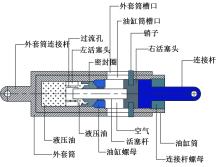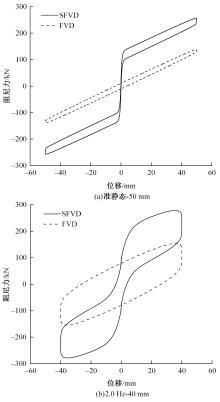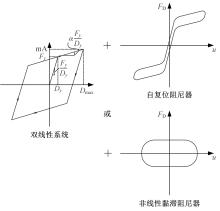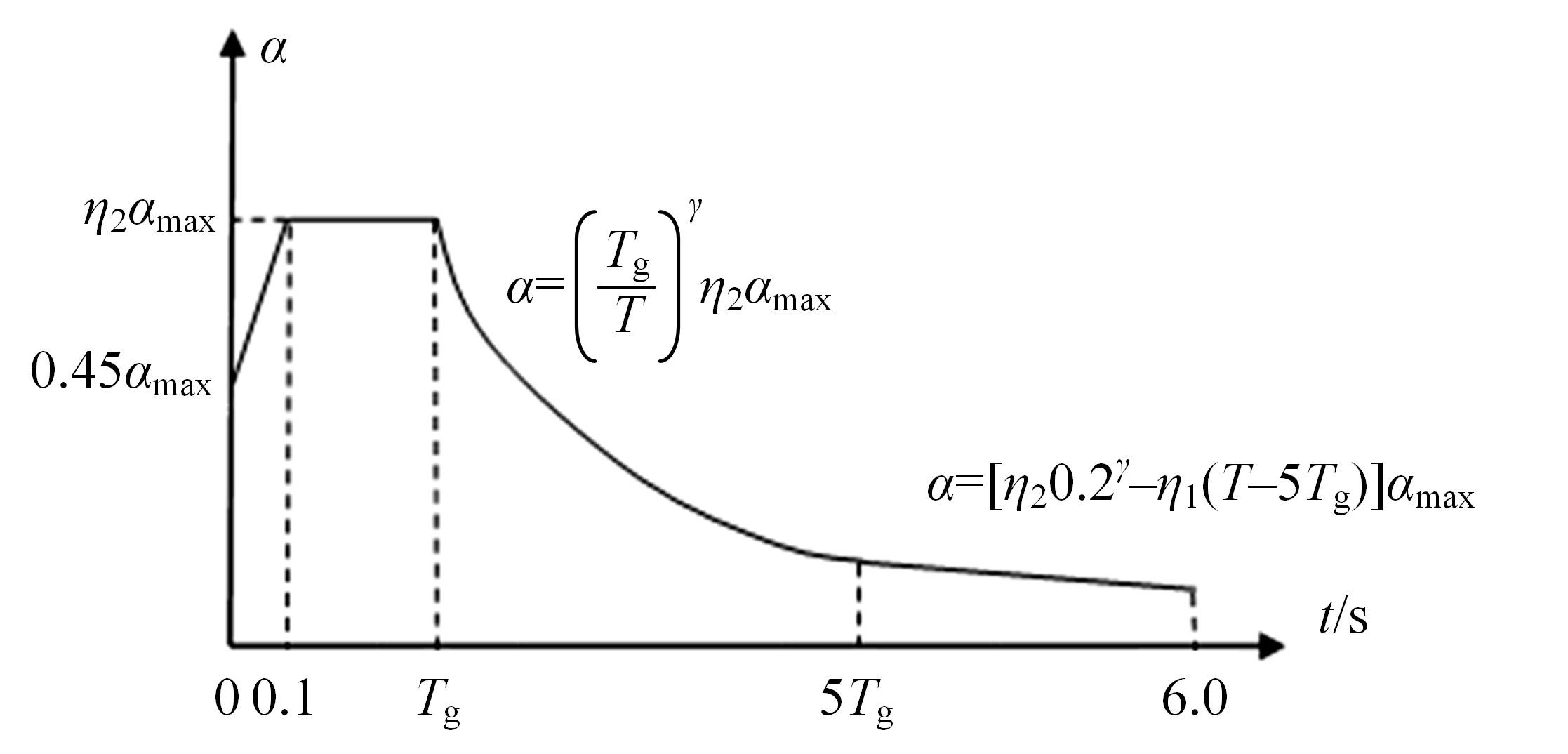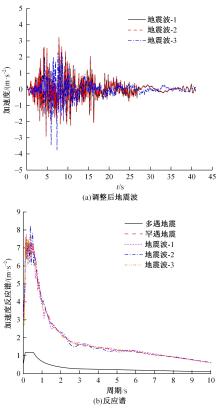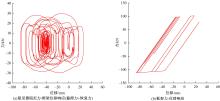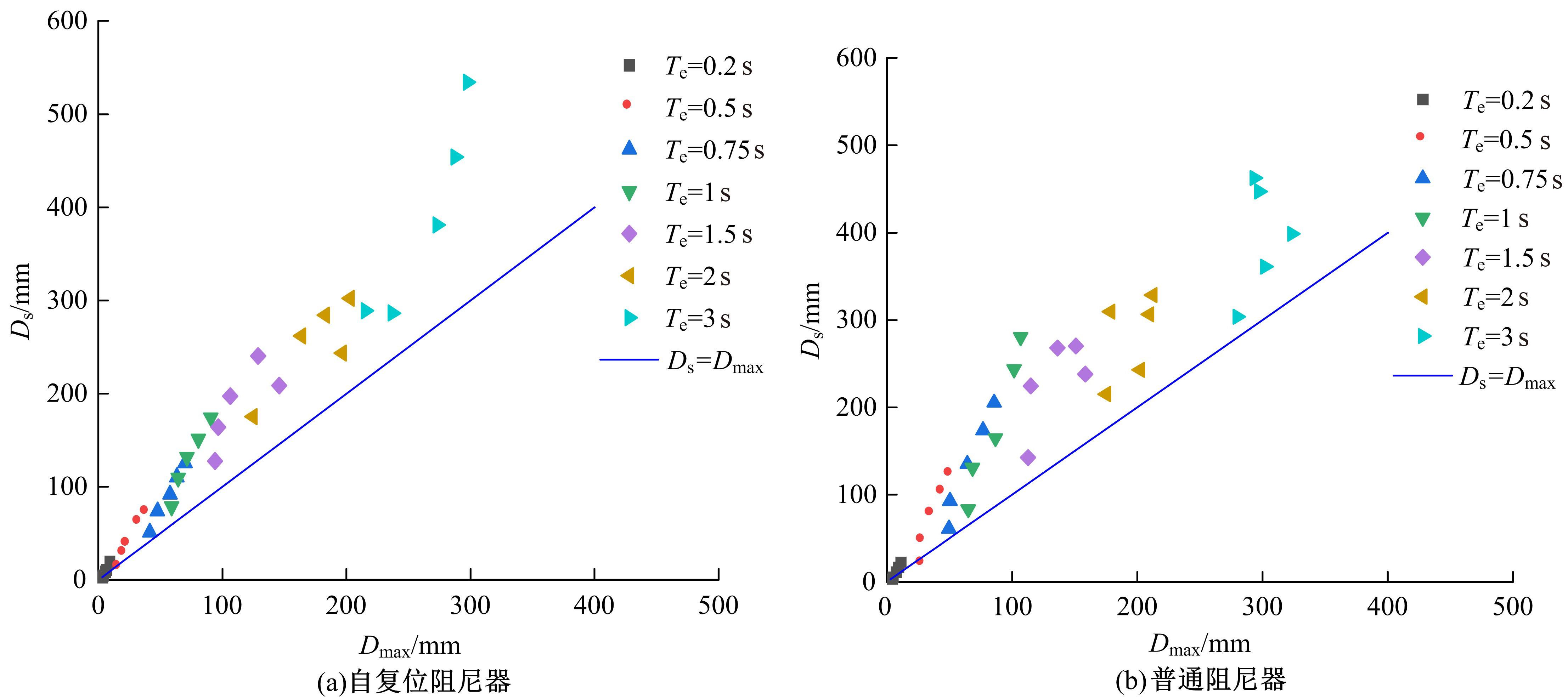吉林大学学报(工学版) ›› 2023, Vol. 53 ›› Issue (11): 3141-3150.doi: 10.13229/j.cnki.jdxbgxb.20220138
一种新型自复位黏滞阻尼器的性能及应用
- 宁波大学 土木工程与地理环境学院,浙江 宁波 315211
Performance and application of novel self-centering viscous damper
- School of Civil & Environmental Engineering and Geography Science,Ningbo University,Ningbo 315211,China
摘要:
为进一步提高框架结构震后可修复性,降低建筑物地震残余位移,提出了增设自复位黏滞阻尼器加固方案。建立了自复位黏滞阻尼器的力学模型,利用一组黏滞阻尼器力学性能试验进行了验证,分析了3种初始压力下阻尼力特征,提出了单自由度框架安装黏滞阻尼器的抗震简化计算方法,并利用时程分析进行了验证。结果表明:在同一初始预压力下,随着加载频率的提高,屈服阻尼力、峰值阻尼力、耗能和等效阻尼比随之增大;在相同加载频率和位移幅值下,随着预压力的增大,屈服阻尼力、峰值阻尼力和能量耗散提高。时程分析表明随着结构周期增大,位移需求增大,自复位阻尼器方案框架底部剪力与普通阻尼器方案基本一致,普通阻尼器方案位移需求大于自复位阻尼器方案。自复位黏滞阻尼器可以用于高烈度区框架结构的抗震加固,相比于普通黏滞阻尼器具有较好的抗震性能。
中图分类号:
- TU391
| 1 | 王社良. 抗震结构设计[M]. 4. 武汉:武汉理工大学出版社, 2011. |
| 2 | 许卫晓, 程扬, 杨伟松, 等. RC框架-抗震墙并联结构体系拟静力试验[J]. 吉林大学学报:工学版, 2021, 51(1): 268-277. |
| Xu Wei-xiao, Cheng Yang, Yang Wei-song, et al. Quasi-static test of RC frame-seismic wall dual structural system[J]. Journal of Jilin University(Engineering and Technology Edition), 2021, 51(1): 268-277. | |
| 3 | 潘鹏, 叶列平, 钱稼茹, 等. 建筑结构消能减震设计与案例[M]. 北京: 清华大学出版社, 2014. |
| 4 | 龚宇伟, 布占宇. 黏滞阻尼器在框架结构抗震加固中的应用研究[J]. 施工技术,2019,48(15): 25-28. |
| Gong Yu-wei, Bu Zhan-yu. Application research of viscous damper in seismic strengthening for frame structures[J]. Construction Technology, 2019, 48(15): 25-28. | |
| 5 | 江辉,李新,白晓宇.桥梁抗震结构体系发展述评:从延性到韧性[J]. 吉林大学学报:工学版, 2023, 53(6): 1550-1565. |
| Jiang Hui, Li Xin, Bai Xiao-yu. Review on development of bridge seismic structural systems: from ductility to resilience[J]. Journal of Jilin University(Engineering and Technology Edition), 2023, 53(6): 1550-1565. | |
| 6 | 翁大根, 卢著辉, 徐斌, 等. 粘滞阻尼器力学性能试验研究[J]. 世界地震工程, 2002, 18(4): 30-34. |
| Weng Da-gen, Lu Zhu-hui, Xu Bin, et al. The experimental study on property of energy dissipation of viscous liquid damper[J]. World Earthquake Engineering, 2002, 18(4): 30-34. | |
| 7 | 陈通, 翁大根, 胡岫岩, 等. 考虑近断层地震的隔震结构增设黏滞阻尼器效果分析[J]. 结构工程师, 2013, 29(1): 92-99. |
| Chen Tong, Weng Da-gen, Hu Xiu-yan, et al. Analysis of an base-isolated structure with viscous dampers to near-fault ground motions[J]. Structural Engineers, 2013, 29(1): 92-99. | |
| 8 | 翁大根. 消能减震结构理论分析与试验验证及工程应用[D]. 上海: 同济大学土木工程学院, 2006. |
| Weng Da-gen. Theoretical analysis and test verification and practice for the structures with energy dissipation device[D]. Shanghai: School of Civil Engineering, Tongji University, 2006. | |
| 9 | Dargush G F, Sant R S. Evolutionary aseismic design and retrofit of structures with passive energy dissipation[J]. Earthquake Engineering and Structural Dynamics, 2005, 34: 1601-1626. |
| 10 | Lavan O, Levy R. Optimal design of supplemental viscous damper for linear framed structures[J]. Earthquake Engineering and Structural Dynamics, 2006, 35: 337-356. |
| 11 | Sellemah A A, Constantinou M C. Investigation of seismic response of buildings with linear and nonlinear fluid viscous dampers[R]. Technical Report NCEER-97-0004, United States: State University of New York at Buffalo, 1997. |
| 12 | Ramirez O M, Constantinou M C, Kircher C A, et al. Development and evaluation of simplified procedures for analysis and design of buildings with passive energy dissipation systems[R]. Technical Report MCEER-00-0010, Revision 1, United States: State University of New York at Buffalo, 2001. |
| 13 | 布占宇, 龚宇伟, 刘婧涵, 等. 一种粘滞阻尼器[P]. 中国. |
| 14 | Kitayama S, Constantinou M C. Development and evaluation of procedures for analysis and design of buildings with fluidic self-centering systems[R]. Technical Report MCEER-16-0003, United States: State University of New York at Buffalo, 2016. |
| 15 | (2016版). 建筑抗震设计规范 [S]. |
| [1] | 田国红,代鹏杰. 基于单亲遗传算法的无人驾驶汽车主动避撞方法[J]. 吉林大学学报(工学版), 2023, 53(8): 2404-2409. |
| [2] | 肖阳,王洁,刘孟军,杨发庆,张天瑶,兰巍. 质子交换膜燃料电池气体扩散层的力学改进模型[J]. 吉林大学学报(工学版), 2022, 52(9): 2147-2155. |
| [3] | 陈伟宏,陈艳,洪秋榕,崔双双,颜学渊. BRBs加固震损装配式混凝土框架结构抗震性能试验[J]. 吉林大学学报(工学版), 2022, 52(8): 1817-1825. |
| [4] | 孙健,彭斌,朱兵国. 新型无油涡旋压缩机内部热力学特性和性能测试[J]. 吉林大学学报(工学版), 2022, 52(12): 2778-2787. |
| [5] | 王新彦,江泉,吕峰,易政洋. 基于参数化模型的零转弯半径割草机侧翻稳定性[J]. 吉林大学学报(工学版), 2021, 51(5): 1908-1918. |
| [6] | 李洪雪,李世武,孙文财,王琳虹,杨志发. 考虑垂向⁃侧向运动的半挂列车动力学建模及分析[J]. 吉林大学学报(工学版), 2021, 51(2): 549-556. |
| [7] | 许卫晓,程扬,杨伟松,鞠佳昌,于德湖. RC框架⁃抗震墙并联结构体系拟静力试验[J]. 吉林大学学报(工学版), 2021, 51(1): 268-277. |
| [8] | 王秀振,钱永久,邵长江,宋帅. 考虑楼层相关性的框架结构地震易损性分析[J]. 吉林大学学报(工学版), 2020, 50(1): 202-209. |
| [9] | 李战东,陶建国,罗阳,孙浩,丁亮,邓宗全. 核电水池推力附着机器人系统设计[J]. 吉林大学学报(工学版), 2018, 48(6): 1820-1826. |
| [10] | 胡满江, 罗禹贡, 陈龙, 李克强. 基于纵向频响特性的整车质量估计[J]. 吉林大学学报(工学版), 2018, 48(4): 977-983. |
| [11] | 刘祥勇, 李万莉. 包含蓄能器的电液比例控制模型[J]. 吉林大学学报(工学版), 2018, 48(4): 1072-1084. |
| [12] | 王倩, 赵丁选, 赵颖, 陈娜. 舰载直升机复杂舰面上的动力学分析[J]. 吉林大学学报(工学版), 2017, 47(4): 1109-1113. |
| [13] | 董超, 成凯, 胡康乐, 胡文强. 全地形铰接式履带车辆俯仰运动性能[J]. 吉林大学学报(工学版), 2017, 47(3): 827-836. |
| [14] | 舒浩, 史江义, 马佩军, 潘伟涛, 杨林安. 基于花环网络的偏转直通片上网络框架结构[J]. 吉林大学学报(工学版), 2017, 47(3): 988-995. |
| [15] | 高振海, 高菲, 胡宏宇, 何磊, 兰巍, 程悦. 车辆驾乘人员不同坐姿时腰腹部骨肌力学特性分析[J]. 吉林大学学报(工学版), 2017, 47(1): 35-40. |
|

